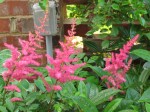 Also called false spirea, Astilbe is a genus of herbaceous perennials and members of the saxifrage family, Saxifrageceae, that also includes coralbells (heuchera), Bergenia, and Tiarella. Most astilbes are native to Asia where they grow in woodlands and mountain ravines. Plants grow 8″ to 4′ tall from thick fibrous-rooted crown that are often woody. The leaves are usually divided 2-3 times with toothed leaflets and form a handsome clump that is an asset in the garden even when the plant is not blooming. The tiny flowers are carried in plum-like clusters 6′-24″ long and may be red, magenta, rose, pink, lavender, lilac, cream or white. Red flowered hybrids tend to have a bronze tinge on their stems and leaves. The genus name Astilbe comes from the Greek words a meaning without, and stilbe meaning brightness and refers to dullness of the leaves of some species.Astilbes like shade and and moisture; dry soil can wreck havoc with the foliage sometimes leading to the death of the plant. Given partial shade and deep moist soil plants thrive and provide long lasting flowers from late spring into summer depending on the species. Although some species are tall, none of them require staking. Plants can be propagated by seed but division in spring is far easier and successful. Tall species are good for the back of the border while low growing ones are suitable for the front of the border or in rockeries. Groups planted around water features are especially effective and flowers are beautiful in bouquets.
Also called false spirea, Astilbe is a genus of herbaceous perennials and members of the saxifrage family, Saxifrageceae, that also includes coralbells (heuchera), Bergenia, and Tiarella. Most astilbes are native to Asia where they grow in woodlands and mountain ravines. Plants grow 8″ to 4′ tall from thick fibrous-rooted crown that are often woody. The leaves are usually divided 2-3 times with toothed leaflets and form a handsome clump that is an asset in the garden even when the plant is not blooming. The tiny flowers are carried in plum-like clusters 6′-24″ long and may be red, magenta, rose, pink, lavender, lilac, cream or white. Red flowered hybrids tend to have a bronze tinge on their stems and leaves. The genus name Astilbe comes from the Greek words a meaning without, and stilbe meaning brightness and refers to dullness of the leaves of some species.Astilbes like shade and and moisture; dry soil can wreck havoc with the foliage sometimes leading to the death of the plant. Given partial shade and deep moist soil plants thrive and provide long lasting flowers from late spring into summer depending on the species. Although some species are tall, none of them require staking. Plants can be propagated by seed but division in spring is far easier and successful. Tall species are good for the back of the border while low growing ones are suitable for the front of the border or in rockeries. Groups planted around water features are especially effective and flowers are beautiful in bouquets.
The following astilbes are excellent garden plants:
A. x arendsii
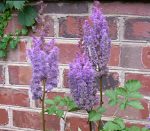 These hybrids are the result of crossing many different species and are the most widely grown. Among the 50+ cultivars available the following are particularly populst and easy to find: ‘Bridal Veil’ (off-white, mid-season), ‘Deutschland'(white, early), ”Bressingham Beauty’ (rich pink, late), ‘Erica’ (clear pink, mid-season), Ostrich Plume’, ‘Rhineland’ (clear pink, early), Bremen’ (bright red,early), ‘Final’ (red, early), ‘Amethyst’ (lavender, early)
These hybrids are the result of crossing many different species and are the most widely grown. Among the 50+ cultivars available the following are particularly populst and easy to find: ‘Bridal Veil’ (off-white, mid-season), ‘Deutschland'(white, early), ”Bressingham Beauty’ (rich pink, late), ‘Erica’ (clear pink, mid-season), Ostrich Plume’, ‘Rhineland’ (clear pink, early), Bremen’ (bright red,early), ‘Final’ (red, early), ‘Amethyst’ (lavender, early)
Height: 2-4′
Flower Color: White, cream, pink, red
Bloom Time: Late spring to summer
Hardiness: Zones 4-9
A. biternate
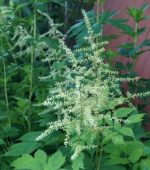 The only astilbe native to North America!
The only astilbe native to North America!
Height: 3-5′
Flower Color: Off white
Bloom Time: Late spring into summer
Hardiness: Zones 4-7
A. chinensis var. pumila
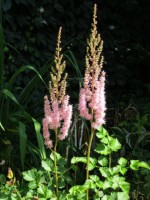 Spreads rapidly and an excellent as a ground cover in moist shady area.
Spreads rapidly and an excellent as a ground cover in moist shady area.
Height: 1′
Flower Color: Rose-pink
Bloom Time: Summer to late summer
Hardiness: Zones 3-8
A. x rosea
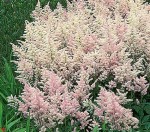 Result of cross between A. chinensis and A. japonica. Popular cultivar is ‘Peach Blossom’ (3-4′ tall,salmon pink flowers in large anicles)
Result of cross between A. chinensis and A. japonica. Popular cultivar is ‘Peach Blossom’ (3-4′ tall,salmon pink flowers in large anicles)
Height: 2-3′
Flower Color: Pink
Bloom Time: Mid-summer
Hardiness: Zones 4-8
A. simplicifolia
![]() Unlike most other astilbes the foliage is lobed rather than divided. ‘Sprite’ with shell pink flowers and bronze foliage is an outstanding cultivar.
Unlike most other astilbes the foliage is lobed rather than divided. ‘Sprite’ with shell pink flowers and bronze foliage is an outstanding cultivar.
Height: 8-18″
Flower Color: White (cultivars pink to red)
Bloom Time: Early summer to summer
Hardiness: Zones 4-8
A. taquetii
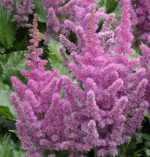 The latest astilbe to bloom and the most heat and drought tolerant
The latest astilbe to bloom and the most heat and drought tolerant
Height: 2-4′
Flower Color: Lilac, pink
Bloom Time: Late summer to early fall
Hardiness: Zones 4-8
A. thunbergii
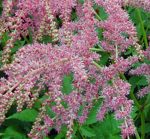 With hairy foliage and nodding flower clusters, this astilbe is eye-catching.
With hairy foliage and nodding flower clusters, this astilbe is eye-catching.
Height: 2-3′
Flower Color: White, pink, salmon
Bloom Time: Mid to late summer
Hardiness: Zones 4-8